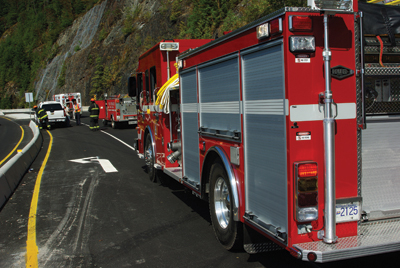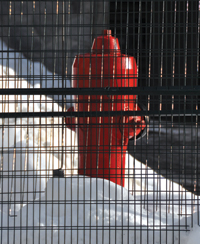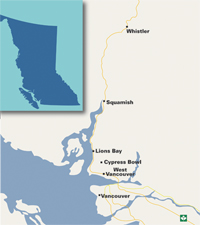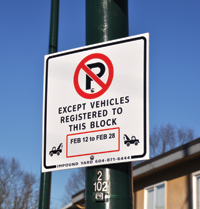
Headlines
News
Olympic feat
Like everyone connected with the 2010 Olympics in British Columbia, Lions Bay Fire Chief Andrew Oliver wants to perform to the best of his ability. His task – and that of his 30-member volunteer department, along with colleagues from Squamish Fire Rescue and Whistler Fire Rescue
February 17, 2010
By Paul Dixon
Like everyone connected with the 2010 Olympics in British Columbia, Lions Bay Fire Chief Andrew Oliver wants to perform to the best of his ability. His task – and that of his 30-member volunteer department, along with colleagues from Squamish Fire Rescue and Whistler Fire Rescue – is road rescue along the newly widened and repaired but still treacherous Sea to Sky Highway between Vancouver and Whistler.
With the highway between Squamish and Whistler restricted to Olympic traffic, including hundreds of highway coaches that will transport athletes, executives and media to and from Whistler every day, Oliver secured $30,000 in provincial funding to buy new cutters and spreaders and to develop and deliver road-rescue training to firefighters in the three departments.
 |
| Fire departments operating along the winding Sea To Sky Highway between Vancouver and Whistler expect to have their work cut out for them during the 2010 Olympic Games this month with potentially bad weather and hundreds of buses travelling the route daily.
|
In early November, Oliver and Bob Allan, who runs a vehicle extrication training company called Rescue Associates, travelled at their own expense to the Prevost bus factory in Sainte-Claire, Que., to see first hand how its buses are built in order to better understand how to take them apart.
Rescue Associates then presented a two-day train-the-trainer workshop for Lions Bay, Squamish and Whistler that specifically addressed highway coaches and mass-casualty triage. (Prevost had arranged for a new coach to be provided by Charter Bus Lines of B.C. for demonstration purposes.) In January, Lions Bay conducted a full-scale functional exercise simulating a highway coach crash and mass casualty triage.
As is often the case in the Canadian fire service, Chief Oliver, with the backing of then-Chief Ray Saurette of Squamish and Chief Rob Whitton of Whistler, took the initiative and negotiated staffing levels and funding with the province to ensure adequate response to highway crashes during the Olympics.
Initially, the province was willing to pay for two firefighters to respond on a rescue unit 24/7 but Oliver was able to raise that to four firefighters 24/7 for the duration of the Games.
In addition, while security for the Games is being bolstered by thousands of RCMP and other police from across Canada, augmented by 5,000 Canadian Forces personnel and up to 10,000 private security personnel, Games organizers are relying on local fire departments for public safety and fire protection with no outside support. Vancouver-area fire departments say they can manage any Games-related emergencies or incidents but the ability of departments to respond to incidents within their communities with so many of their resources committed to the Games seems questionable. BC Ambulance, another key player in public safety during the Games, can draw on its province-wide service for personnel and resources.
■ Who’s responsible?
Public safety planning for the Games is the responsibility of the Integrated Public Safety Unit (IPSU) operating under the B.C. Ministry of Public Safety and the Solicitor General, including the B.C. Office of the Fire Commissioner, BC Ambulance Service, the Provincial Emergency Program, the B.C. Coroners Service and the Vancouver Organizing Committee’s Fire Advisory Committee, which comprises fire department representatives from the communities directly affected by the Olympics.
 |
|
| At many Olympic sites, security fencing obstructs access to hydrants and building connections. |
Fire departments in Vancouver, Richmond, West Vancouver and Whistler have agreements with the provincial government to be compensated for services above normal levels in their communities outside of the Olympic domains, and for any services provided within the Olympic domain. Departments that have apparatus placed in Olympic venues are being paid for the apparatus. Overtime pay for firefighters is a separate line item. The three fire departments in communities along the Sea To Sky Highway that provide road rescue will also be compensated.
Whistler Fire Rescue, with 24 career members and 60 paid on-call members, is providing 24/7 on-site coverage to the Whistler athletes village – home to 2,800 – and site coverage for the downhill ski facility on Whistler Mountain. It is also staffing an engine, a quint and a rescue unit 24/7 for the duration of the Games, using on-call firefighters with career staff as company officers.
Whistler Fire Chief Whitton describes the planning surrounding the Games as “a great blend of enthusiasm and experience”. While Whistler has a huge responsibility, Chief Whitton says he “has no doubts we can deal with what comes our way based on what we have planned for”.
He says his department has always had a good working relationship with the local RCMP detachment and this has carried over to the Games’ Integrated Security Unit. Unified command has been established for all venues and into the community as well.
Richmond Fire Rescue will have four firefighters stationed inside the Olympic speed skating facility. Richmond is also providing structural firefighting response to Vancouver International Airport, which will see a tremendous increase in passenger traffic with up to 250,000 extra arrivals in the days leading up to the Olympics. Airport authorities anticipate 39,000 departures on March 1, the day after the Olympic closing ceremonies, 50 per cent more than on its previous record day. Richmond also has responsibility for the O Zone, the Olympics outdoor celebration area that hosts free entertainment and is expected to draw 15,000 people a day, centred around the Heineken House club that holds up to 4,000 celebrants.
 |
|
| Click here to see larger image |
West Vancouver Fire & Rescue will provide 24/7 on-site fire protection to the freestyle skiing and snowboard facility at Cypress Bowl, as well road rescue on the Trans-Canada and Sea To Sky highways. West Vancouver is also responsible for a celebration site that offers nightly live entertainment and medal ceremonies.
Lions Bay Fire Rescue is providing four members 24/7 from its department for road rescue on the Sea To Sky while Squamish Fire Rescue, which has a career day shift Monday to Friday, will provide four members 24/7 for road rescue.
Whistler Olympic Park, in the Callaghan Valley south of Whistler and the site of the cross-country events, biathlon and ski jumping, is in provincial territory not covered by an organized fire department. For the duration of the Games, fire protection will be provided by fire departments from other regions of B.C. under arrangements with Emergency Management B.C. and the Office of the Fire Commissioner. A temporary fire hall is being erected to house two engines and a water tender. The Callaghan site, developed for the Olympics, has few permanent structures but hundreds of temporary buildings, large tents and scores of electrical generators.
Vancouver Fire & Rescue has the lion’s share of the responsibility. Its jurisdiction includes:
- B.C. Place Stadium, which hosts the opening and closing ceremonies;
- GM Place, the venue for hockey and figure skating;
- the Pacific Coliseum, which is being used for hockey, figure skating and short-track speed skating;
- UBC Thunderbird Arena, another hockey venue;
- the Vancouver Olympic/Paralympic Centre at Little Mountain, where the curling is held;
- the Vancouver Convention Centre, home to the media, where more than 200 studio spaces have been fabricated on the floor of the main exhibit hall, with hundreds of millions of dollars worth of equipment.
- and the Vancouver Olympic athletes village and its population of 3,000.
In addition, several Vancouver community centre ice rinks are being used as practice facilities.
All the venues are surrounded by a large number of temporary structures providing a number of support services construction trailers, tents and canopies. The sites at Whistler and Cypress Bowl have temporary seating for up to 10,000 people in open bleachers, with scores of media suites arrayed at the back of the bleachers in tiers, tens of metres above the ground. Electrical power is provided by scores of generator units. At many sites the security fencing obstructs access to hydrants and building connections.
John Pentland, training chief with VFRS, was seconded to the Integrated Public Safety Unit for more than two years as one of the key planners, returning to VFRS in August to take responsibility for integrating that planning into operation.
“We will likely be pre-staging apparatus in the downtown core depending on the volume of people on the streets,” he said. “Our people will find themselves spending a lot more time out of station than they are used to.”
Besides the competition venues and media centres, a large portion of downtown Vancouver will be turned over to the Games, either as part of the locked-down security zone or as part of the much larger public celebration area, in which a number of arterial streets will be turned into pedestrian malls by banning vehicles, connecting pavilions, open air stages and celebration zones to encourage people to come downtown and take part in the festivities. One police official described it as being “fireworks every night” in reference to the annual Symphony of Fire fireworks that draws as many as 350,000 people downtown for four nights each summer.
All the venues and facilities inside the Games security cordon will have at least a crew of firefighters during competition times or possibly firefighters and apparatus on site for the duration of the Games, depending on the facility and the pre-plan. Everybody working inside the security zone has to obtain a Games security clearance, which is much more than a simple criminal record search. Any emergency vehicles required to enter a security zone must undergo a thorough search and all personnel require their Games ID to be allowed entry.

|
|
|
|
■ Funding
Funding for fire departments that are providing Olympic service came at the eleventh hour. While the formulas are complex and the agreements differ for the various municipalities, effectively the province is providing funding to cover service above normal levels when it is related to the Olympics. With the best of intentions, requirements had been identified well in advance but the severe downturn in provincial revenues prompted a freeze on all spending by the provincial government.
In the meantime, the province legislated striking BC Ambulance paramedics back to work just in time to guarantee that BCAS would be able to honour its Olympic commitment. BCAS is bringing in personnel from around the province to meet its commitment of between 100 and 120 extra paramedics a day in metro Vancouver, both for work inside venues and to bolster regional resources.
■ Road rescue
Two areas of concern are the Sea To Sky highway, as the only road link between Vancouver and Whistler, and the impact the anticipated crowds in downtown Vancouver will have on the ability of emergency responders to move about the area.
The Sea To Sky highway, having just undergone a $900-million upgrade, is still one of the most challenging stretches of road in North America. The Vancouver Organizing Committee (VANOC) is running as many as 600 highway coaches a day between Whistler and Vancouver, transporting spectators, Games volunteers, media, officials and others starting at 5 a.m. The municipality of Whistler has engaged a fleet of 140 coaches to provide transportation service between Whistler and Vancouver, in addition to Greyhound and existing public transit service between Squamish and Whistler. There will be no public parking or on-street parking anywhere in Whistler for the duration of the Games.
RCMP are bringing in accident investigation teams from across western Canada to expedite accident investigations on the highway. Heavy tow trucks will be posted along the road to clear accidents and keep the road open. There seems to have been little consideration given to the reality that before the accident investigation can begin or the scene cleared, victims have to be triaged and removed from the wreckage. The fire departments that will be responding to any highway crashes will be doing so with their normal level of response. Paying the volunteers 24/7 to be in the hall will mean a much quicker response, but they are still responding with the same level of resources as before and after the Olympics. Given that some responses can be as much as 20 kilometres or more outside their municipality, sending more equipment would strip their communities of fire protection.
■ Crowd control
Vancouverites have a dubious history of handling large outdoor celebratory events in a responsible manner. The Stanley Cup riot of 1994 is just one of several black marks. Vancouver used to host an annual Sea Festival over three weeks each summer but two years of drunken buffoonery and rioting finished it in 1980. What is now the Symphony of Fire began as the Sea Festival fireworks more than 35 years ago.
Whistler and Vancouver have both passed bylaws extending closing hours for licensed premises during the Olympics. Parking has been banned 24/7 on a number of streets leading into the downtown core. Public transit is gearing up for a 50 per cent user increase for the Olympics. If organizers’ dreams are realized, there will be tens of thousands of people out and about in downtown Vancouver every night during the Olympics. Translink, the agency responsible for public transportation in metro Vancouver, began running ads in January advising that while all transit services in the region would be running at peak operating levels for the duration of the Games, they were anticipating long lineups for buses, Skytrain and Seabus of up to two hours for the morning and evening rush hours and every night as events wind down.
Planning for the Olympics has been extensive. Unless something of a planned and deliberate nature aimed at the Olympics occurs, there should not be any problems responding to those incidents that do occur. The problem will be the ability to respond to other events, in the community at large. Will the expected sea of humanity in the downtown core slow the response? Will Vancouverites and Olympic visitors be able to celebrate with some degree of decorum? What if there are two serious accidents on the Sea To Sky highway at the same time?
Print this page